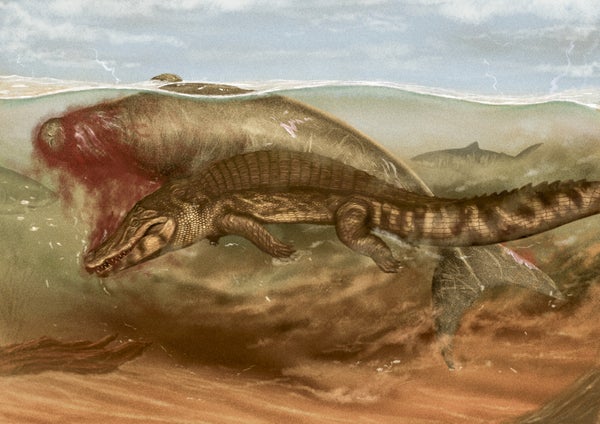August 29, 2024
3 min read
This Ancient Sea Cow Was Killed by a Croc and Eaten by a Shark
Scientists re-create the last moments of a manateelike animal that was eaten by both a crocodilian and a shark

An artist’s depiction of a Culebratherium sea cow being attacked by a crocodilian while a Galeocerdo aduncus tiger shark lurks in the background.
Jaime Bran Sarmiento (illustration); “Trophic Interactions of Sharks and Crocodylians with a Sea Cow (Sirenia) from the Miocene of Venezuela,” by A. Benites-Palomino, in Journal of Vertebrate Paleontology. Published online August 29, 2024 (original publication); (CC BY 4.0).
The circle of life is beautiful and gruesome—sometimes so gruesome that it makes the fossil record downright macabre, millions of years after the fact.
That’s what happened with an ancient manateelike animal whose remains were uncovered in western Venezuela in 2019. The specimen didn’t draw much interest at first; it isn’t particularly well preserved. But as scientists looked closer, they realized the creature’s skull parts and vertebrae were riddled with bite marks—from two very different mouths.
“As soon as you start to take a look at the details, you realize that there is something really special about the animal,” says Aldo Benites-Palomino, a final-year Ph.D. student in paleontology at the University of Zurich. He’s a co-author of a paper published on August 29 in the Journal of Vertebrate Paleontology that reports the find and uses the fossilized evidence of violence to start piecing together how species interacted in this little-studied region of South America.
On supporting science journalism
If you’re enjoying this article, consider supporting our award-winning journalism by subscribing. By purchasing a subscription you are helping to ensure the future of impactful stories about the discoveries and ideas shaping our world today.
“Bite marks are really interesting to study because you don’t feel like a paleontologist—you feel mostly like a forensic specialist,” Benites-Palomino says. The case at hand:
Victim: one sea cow, genus Culebratherium—perhaps 16 feet long, although the fossil isn’t well enough preserved for the researchers to be sure.
Time of death: early to mid-Miocene, 23 million to 11.6 million years ago.
Scene of the crime: an ancient coastline of brackish water and mangrovelike forests.
Benites-Palomino and his colleagues began their investigation by identifying three different types of bite wounds on the fossilized bones. One type of bite mark left small, circular indentations on the sea cow bone. Another left deep, round pits with an incision arcing off them. And yet another left narrow, slitlike marks with triangular imprints.
And then there was what paleontologist Sally Walker of the University of Georgia, who was not involved in the new research, calls a “smoking tooth”: a fossilized chomper found embedded in the fossil between the sea cow’s neck and ribcage. The stray tooth, from an extinct tiger shark called Galeocerdo aduncus, suggests that the slitlike marks were left by the same shark scavenging on the sea cow’s remains, the study’s researchers say. This sort of scavenging is also likely why the skeleton is so fragmentary: messy eaters probably tore off pieces of the carcass and carried them away. Walker says that she’d like to see evidence that shark teeth are uncommon in the area to rule out a coincidental find, however.
Meanwhile Benites-Palomino and his colleagues attributed the first two types of bite marks to some kind of crocodilian—although pointing the finger at a specific suspect species is tricky, he says. That’s because the area at the time was what he calls “a paradise for crocodilians” and because members of this order often have similarly sized teeth even when their body size varies. “Unless it’s something gigantic or something tiny, it’s really difficult” to pinpoint what species was doing the biting, Benites-Palomino says.
The researchers posit that the crocodilian first snapped at the sea cow’s snout—leaving the small circular indentations—then snatched at the animal and used its tail to spiral its body and tear at the animal in what scientists term a “death roll.”
The death roll is a common tactic among nearly all modern crocodilians, says Stephanie Drumheller, a paleontologist at the University of Tennessee, Knoxville, who was not involved in the new research. Even though it’s a plausible technique for an ancient crocodilian to have used, she’s not convinced the behavior ties to the curving bite marks as tightly as the researchers suggest, however. “Positively lining up bite marks with specifically the death roll—I’m not comfortable with that,” she says. “It’s not a nice, neat one-to-one.”
In the end, the team’s story of what exactly happened to the battered sea cow is just a hypothesis, Walker emphasizes, and one that may never be proven. But whatever exactly befell the unlucky creature all those millions of years ago, its fate speaks to the complexity of its ecosystem and is a compelling reminder, all three scientists say, that ancient food webs were just as intricate as modern ones. “Bite marks give us this amazing window into the food webs in these extinct ecosystems,” Drumheller says.
And because the formation the sea cow was found in has been very little studied, there’s still a lot to learn about this Venezuelan area’s distant past, the scientists behind the new research say. It’s just one of a host of compelling discoveries made in South America, says Benites-Palomino, who hails from Peru and works with colleagues from across the continent. “I’m in the middle of the start of this golden age of paleontology in South America,” he says. “We’re discovering quite a lot of material in every single country.”


































